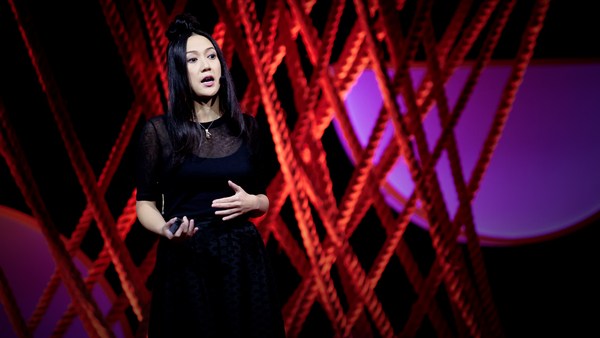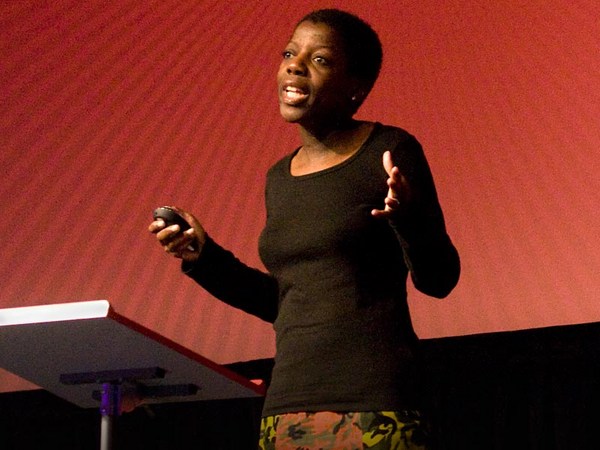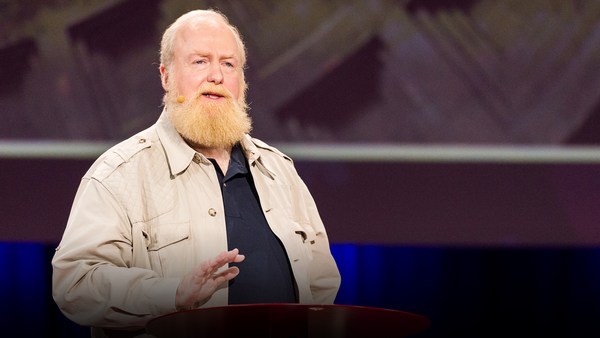I'm an artist and an engineer. And lately, I've been thinking a lot about how technology mediates the way we perceive reality. And it's being done in a superinvisible and nuanced way. Technology is designed to shape our sense of reality by masking itself as the actual experience of the world. As a result, we are becoming unconscious and unaware that it is happening at all.
Take the glasses I usually wear, for example. These have become part of the way I ordinarily experience my surroundings. I barely notice them, even though they are constantly framing reality for me. The technology I am talking about is designed to do the same thing: change what we see and think but go unnoticed.
Now, the only time I do notice my glasses is when something happens to draw my attention to it, like when it gets dirty or my prescription changes. So I asked myself, "As an artist, what can I create to draw the same kind of attention to the ways digital media -- like news organizations, social media platforms, advertising and search engines -- are shaping our reality?" So I created a series of perceptual machines to help us defamiliarize and question the ways we see the world.
For example, nowadays, many of us have this kind of allergic reaction to ideas that are different from ours. We may not even realize that we've developed this kind of mental allergy. So I created a helmet that creates this artificial allergy to the color red. It simulates this hypersensitivity by making red things look bigger when you are wearing it. It has two modes: nocebo and placebo. In nocebo mode, it creates this sensorial experience of hyperallergy. Whenever I see red, the red expands. It's similar to social media's amplification effect, like when you look at something that bothers you, you tend to stick with like-minded people and exchange messages and memes, and you become even more angry. Sometimes, a trivial discussion gets amplified and blown way out of proportion. Maybe that's even why we are living in the politics of anger. In placebo mode, it's an artificial cure for this allergy. Whenever you see red, the red shrinks. It's a palliative, like in digital media. When you encounter people with different opinions, we will unfollow them, remove them completely out of our feeds. It cures this allergy by avoiding it. But this way of intentionally ignoring opposing ideas makes human community hyperfragmented and separated.
The device inside the helmet reshapes reality and projects into our eyes through a set of lenses to create an augmented reality. I picked the color red, because it's intense and emotional, it has high visibility and it's political. So what if we take a look at the last American presidential election map through the helmet?
(Laughter)
You can see that it doesn't matter if you're a Democrat or a Republican, because the mediation alters our perceptions. The allergy exists on both sides.
In digital media, what we see every day is often mediated, but it's also very nuanced. If we are not aware of this, we will keep being vulnerable to many kinds of mental allergies.
Our perception is not only part of our identities, but in digital media, it's also a part of the value chain. Our visual field is packed with so much information that our perception has become a commodity with real estate value. Designs are used to exploit our unconscious biases, algorithms favor content that reaffirms our opinions, so that every little corner of our field of view is being colonized to sell ads. Like, when this little red dot comes out in your notifications, it grows and expands, and to your mind, it's huge.
So I started to think of ways to put a little dirt, or change the lenses of my glasses, and came up with another project. Now, keep in mind this is conceptual. It's not a real product. It's a web browser plug-in that could help us to notice the things that we would usually ignore. Like the helmet, the plug-in reshapes reality, but this time, directly into the digital media itself. It shouts out the hidden filtered voices. What you should be noticing now will be bigger and vibrant, like here, this story about gender bias emerging from the sea of cats.
(Laughter)
The plug-in could dilute the things that are being amplified by an algorithm. Like, here in this comment section, there are lots of people shouting about the same opinions. The plug-in makes their comments super small.
(Laughter)
So now the amount of pixel presence they have on the screen is proportional to the actual value they are contributing to the conversation.
(Laughter)
(Applause)
The plug-in also shows the real estate value of our visual field and how much of our perception is being commoditized. Different from ad blockers, for every ad you see on the web page, it shows the amount of money you should be earning.
(Laughter)
We are living in a battlefield between reality and commercial distributed reality, so the next version of the plug-in could strike away that commercial reality and show you things as they really are.
(Laughter)
(Applause)
Well, you can imagine how many directions this could really go. Believe me, I know the risks are high if this were to become a real product. And I created this with good intentions to train our perception and eliminate biases. But the same approach could be used with bad intentions, like forcing citizens to install a plug-in like that to control the public narrative. It's challenging to make it fair and personal without it just becoming another layer of mediation.
So what does all this mean for us? Even though technology is creating this isolation, we could use it to make the world connected again by breaking the existing model and going beyond it. By exploring how we interface with these technologies, we could step out of our habitual, almost machine-like behavior and finally find common ground between each other.
Technology is never neutral. It provides a context and frames reality. It's part of the problem and part of the solution. We could use it to uncover our blind spots and retrain our perception and consequently, choose how we see each other.
Thank you.
(Applause)





